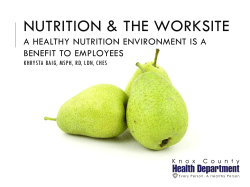
Blumberg ppp final - Institute on Science for Global Policy
Ensuring Food and Nutrition Security through Changes in Food Development, Processing, and Culture** Jeffrey B. Blumberg, Ph.D., FASN, FACN Professor, Friedman School of Nutrition Science and Policy and Jean Mayer USDA Human Nutrition Research Center on Aging, Tufts University. Boston, Massachusetts, U.S. Summary During the next 50 years, the impacts of a worldwide population approaching 10 billion people and inexorable changes in global climate present a critical challenge to food security (i.e., ensuring that sufficient food is available) and nutrition security (i.e., ensuring that food quality meets human nutrient needs). New policies that identify and support solutions to feeding the world are essential; resources such as fertile land and fresh water are diminishing and changes in temperature and atmospheric carbon dioxide can reduce both crop yields and the nutrient quality of important plant foods. Because these problems are complex, solutions must be multipronged. These solutions must directly achieve greater production of nutritious foods with fewer resource inputs, improved food stability for storage and distribution, reduced food loss and waste, broader use of natural foodstuffs, and the development of novel foods using new technologies. Some of these solutions are apparent today and include: (i) using genetically engineered plants (commonly referred to as “genetically modified organisms” [GMOs]) to improve sustainability, yield, and nutrition, (ii) developing processing methods to safely enhance the preservation, storage, nutrient content, and transportation of food, (iii) creating approaches to reduce loss and waste throughout the food supply chain, and (iv) recognizing the value of uncommon and novel foods, e.g., from insects and bioprinting, respectively. Current realities Population growth in the next 50 years could require increases in food production by as much as 60% to meet the global demands of food and nutrition security. However, the Food and Agriculture Organization of the United Nations (FAO) reports that today we have 925 million people who are hungry and many more who are malnourished and food insecure, mostly in less-wealthy countries in Asia and sub-Saharan Africa. In these regions, 100 million children are underweight, and poor nutrition is associated with nearly half of the deaths (3.1 million) in children under the age of 5. Without distracting from the critical problem of childhood malnutrition, it is important to note that modern nutrition science is directed not only to the prevention of protein-energy malnutrition and micronutrient deficiencies, but also to the promotion of optimal physiological function and the reduced risk for common chronic conditions, such as cancer and cardiovascular and neurodegenerative diseases. The resulting demand for greater production and distribution of safe and nutritious food coincides with the impact of climate change, natural resource constraints, and competing resource demands (especially for the production of biofuels), and presents a considerable challenge for agriculture and food systems worldwide. More than 50 years ago, Norman Borlaug and other instigators of the Green Revolution bred new high-yield crop varieties and spread modern agricultural production techniques across the world, saving a billion people from starvation and helping to promote world peace by increasing the food supply. Among smallholder farmers in Asia, the adoption of these new innovations increased productivity and produced enough food to lower the real prices of staple foods for consumers. In addition, the demand for labor in rural areas increased, generating new jobs and increasing wages for poor and unskilled workers, and food security improved. However, increasing occurrences of droughts and flooding, and changing climatic patterns, are now requiring a shift in crops and farming practices that cannot be easily accomplished. The application of new-generation technology, including genetic engineering, can build upon the original successes documented in the Green Revolution. EMBARGOED—NOT FOR PUBLIC DISTRIBUTION Page 1 While food production must increase to meet future demands, it is essential to recognize that one-third of all food (about 1.3 billion tons per year) is currently lost or wasted between agricultural production and household consumption. Food losses in industrialized countries are as high as in less-affluent countries, but in less-affluent countries more than 40% of the food losses occur at the post-harvest and processing levels, while in industrialized countries, more than 40% of the food losses occur at the retail and consumer levels. Annual food waste at the consumer level in more-affluent countries (222 million tons) is almost as high as the total net food production in sub-Saharan Africa (230 million tons). Though the approaches vary between less- and more-affluent countries, food supply chains need to be strengthened through practices such as the promotion of food processing to enhance their preservation, storage, nutrient content, and transportation. In addition to strengthening the food supply chain, introducing uncommon and novel foods can also contribute to food and nutrition security. Uncommon foods are those that are traditionally used in specific regions or cultures but are not widely established elsewhere (e.g., insects [entomophagy] and marine algae) and those that present themselves as particularly sustainable. Novel foods are often defined as those that have never been used as food or that result from a process that has not previously been used for food (e.g., bioprinting, the construction of a biological structure by computer-aided 3-D printing, and cell culture technology), and can be designed to meet specific nutrient needs. Regulations regarding the notification, authorization, specification, and labeling of novel foods vary markedly by country. GMOs are generally regulated differently than novel foods. Scientific opportunities and challenges While unforeseen advances in agricultural, food, and nutrition science cannot be predicted, opportunities are available for further development and application of existing technologies that can promote food security and nutrition security. Genetic engineering, while certainly not a panacea, can increase plant defenses against untoward environmental conditions and/or improve nutrient composition, but its application is hampered by public misunderstanding, fear, and mistrust of the technology. Regulation of GMOs varies enormously between countries with marked impact, as illustrated by the fact that 170 million hectares of genetically modified crops are grown around the world, but cultivation within the European Union is restricted to 0.1 million hectares. Further, current regulation of GMO food is based on how it is produced (“processbased”) rather than on its novelty or potential for harm (“phenotype based”). The process-based approach also confusingly permits organisms with the same phenotype but generated via different technologies to be dealt with differently (e.g., transgenesis versus chemical or radiation mutagenesis). Current policies are unclear on genetic engineering created by methods that were not available when GMO regulations were created 20 years ago. The process-based approach inhibits innovation and misdirects and impairs effective risk management. Emerging technologies in food processing can serve to enhance food safety, increase food supplies, and promote human health. Processes such as ultrahigh temperature pasteurization, ionizing radiation, pulsed electric fields, and high-pressure processing demonstrate these advantages. However, many consumers fail to understand the value of these technologies and often perceive processed foods as inherently less nutritious and unhealthy compared to those marketed as “natural.” Ensuring future food security also requires consideration be given to less common food sources, such as insects and marine algae, and novel foods produced by technologies such as bioprinting and cell cultures (in vitro) to produce “meat” and other foodstuffs. Meeting this goal requires acquisition of new knowledge regarding the attributes and limitations associated with the production and consumption of uncommon and novel foods. EMBARGOED—NOT FOR PUBLIC DISTRIBUTION Page 2 Policy issues Applying Genetic Engineering to Plant Foods • Increase public and private investment in GMOs in order to increase yields and nutrient content, particularly targeted to countering the impact of climate change and to decreasing the use of expensive and potentially harmful inputs (e.g., fertilizers and pesticides) via changes in regulations and taxation by the United States Department of Agriculture (USDA), French National Institute for Agricultural Research (INRA), and FAO. • Expand germplasm repositories (gene banks) and characterize individual plants to identify useful genotypes and phenotypes for the creation of novel cultivars suitable to specific geolocations and environmental conditions, via USDA and FAO. • Make more transparent to the public the benefits and risks of GMOs through educational programs via USDA, FAO, and agencies concerned with public health. • Investigate and promulgate the rational use of GMOs in the context and implementation of good agricultural practices (e.g., integrated pest management, crop rotation, maintenance of soil structure) via USDA and FAO. • Harmonize regulations across countries for GMOs and food ingredients derived from GMOs, including review, approval, and labeling via the FAO, Organisation for Economic Co-operation and Development (OECD), U.S. Food and Drug Administration (FDA), European Food Safety Authority (EFSA), and Codex Alimentarius. • Revise current regulations of GMOs from “process-based” to an approach that focuses instead on their novelty or potential for harm (e.g., their phenotype) via the FDA, USDA, FAO, and EFSA. Applying Food Processing • Use biotechnology and fortification, particularly through the valorization of waste by-products (e.g., via extraction of fiber and polyphenols), to increase nutrient content and density. • Promote safe, stable fresh produce with innovative processing technologies (e.g., non-thermal methods) as well as established but underutilized methods (e.g., irradiation). • Develop educational programs to reverse the adverse perception of food processing among consumers via the Centers for Disease Control and Prevention (CDC) and USDA. Reducing Food Loss and Waste • In less-affluent countries, invest in infrastructure for food processing, storage, transportation, refrigeration, and markets to reduce post-harvest losses of fruits, vegetables, meat, and fish. • In more-affluent countries, market heterogeneous produce to counter “appearance quality standards” that lead to rejection by supermarkets and by consumers. • Modify food processing lines for trimming and related steps for appearance standardization to collect by-products treated as waste that can be valorized for human use. Tapping the Potential of Uncommon and Novel Foods • Explore and characterize the traditional consumption of uncommon foods for large-scale and sustainable applications in a broad range of foods acceptable in other cultures. • Invest in the development of new food technologies, such as bioprinting, molecular gastronomy, nanotechnology, and cultured (in vitro) meat. ** A policy position paper prepared for presentation at the conference on Food Safety, Security and Defense: Focus Food and the Environment, convened by the Institute on Science for Global Policy (ISGP), on October 5-‐8, 2014 at Cornell University, Ithaca, New York, U.S. EMBARGOED—NOT FOR PUBLIC DISTRIBUTION Page 3
© Copyright 2025









